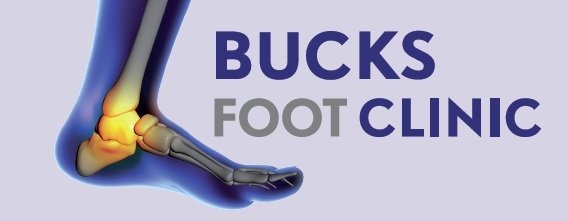
Are you tired of your feet aching after a long day, wondering if there’s something wrong with your shoes—or worse, with your feet themselves? The truth is, most foot discomfort isn’t inevitable or a sign of aging—it’s often a direct result of wearing improper footwear that doesn’t support your unique needs. At Bucks Foot Clinic, we’ve seen countless patients transform their daily comfort simply by learning how to choose proper footwear that truly supports their foot health.
Your feet carry you through approximately 7,500 steps every single day, covering roughly 110,000 miles in your lifetime—equivalent to walking around the Earth more than four times. Yet most people spend more time researching a new mobile phone than they do selecting the shoes that will support this incredible journey. This comprehensive guide will change that, providing you with the knowledge and confidence to make footwear choices that keep your feet comfortable, healthy, and pain-free for life.
Understanding Your Feet: The Foundation of Proper Footwear Selection
Before we can choose the right shoes, we need to understand the remarkable complexity of your feet and how proper footwear supports their intricate function. Your feet aren’t just platforms for standing—they’re sophisticated biomechanical structures that absorb shock, provide stability, and propel you forward with every step.
The Amazing Architecture of Your Feet
Each foot contains 26 bones, 33 joints, and over 100 muscles, tendons, and ligaments working together in perfect harmony when properly supported. This complex structure creates natural arches that act as springs, absorbing the impact of each step and storing energy for the next movement.
Your feet are uniquely yours, with individual characteristics that affect how you walk, stand, and bear weight. Some people have high arches that require specific support, while others have flatter feet that need different accommodation. Understanding your foot type is the first step in selecting proper footwear that works with, rather than against, your natural biomechanics.
How Poor Footwear Disrupts Natural Function
When shoes don’t properly support your feet, every step becomes a struggle against improper alignment and inadequate cushioning. This constant battle leads to fatigue, discomfort, and eventually more serious problems like bunions, plantar fasciitis, or knee and back pain.
Think of improper footwear as forcing your feet to work in an unnatural environment where they can’t function as designed. Over time, this stress accumulates, leading to the aches and pains that many people mistakenly accept as normal parts of aging or daily life.
The Hidden Cost of Wrong Footwear: Why Your Shoe Choices Matter More Than You Think
The impact of improper footwear extends far beyond simple foot discomfort. Poor shoe choices create a domino effect that can affect your entire body, influencing everything from your posture to your energy levels throughout the day.
The Ripple Effect: How Bad Shoes Affect Your Whole Body
Your Knees Pay the Price: Shoes that don’t provide proper support force your feet to roll inward or outward excessively, creating abnormal stress on your knee joints. This misalignment can lead to knee pain, increased wear on cartilage, and a higher risk of injury during physical activities.
Your Hips and Back Join the Struggle: When your feet aren’t properly supported, your entire kinetic chain compensates by making small adjustments that accumulate into significant problems. Poor footwear can contribute to hip pain, lower back discomfort, and even neck tension as your body struggles to maintain balance and alignment.
Your Energy Drains Away: Walking in unsupportive shoes requires significantly more muscular effort than moving in proper footwear. This extra work leads to faster fatigue, reduced endurance, and that heavy, tired feeling in your legs at the end of each day.
The Long-Term Consequences of Footwear Neglect
Structural Changes: Consistently wearing improper footwear can lead to permanent changes in foot structure, including bunions, hammertoes, and arch collapse that may require medical intervention to correct.
Chronic Pain Patterns: What starts as occasional discomfort can develop into chronic pain conditions that significantly impact your quality of life and ability to enjoy physical activities.
Activity Limitations: Many people gradually reduce their activity levels due to foot discomfort, not realising that proper footwear could eliminate their pain and restore their active lifestyle.
Decoding Proper Footwear: The Essential Elements Your Feet Need
Understanding what makes footwear truly supportive empowers you to make informed choices that prioritise your foot health without sacrificing style or personal preferences.
The Foundation Elements of Supportive Shoes
Arch Support That Actually Supports: Proper footwear includes built-in arch support that matches your foot’s natural contours and helps maintain proper alignment during movement. This support should feel comfortable and natural, not forced or uncomfortable.
Heel Counter Stability: The back portion of your shoe should provide firm support around your heel, preventing excessive movement that can lead to blisters, instability, and inefficient gait patterns.
Adequate Toe Box Space: Your toes need room to spread naturally without being compressed or forced into unnatural positions. Proper toe box design prevents bunions, hammertoes, and ingrown toenails while allowing natural foot function.
Cushioning in the Right Places: Effective shock absorption in the heel and forefoot areas reduces the impact forces transmitted through your legs and spine with each step.
Quality Construction That Lasts
Durable Materials: Proper footwear uses high-quality materials that maintain their supportive properties over time rather than breaking down quickly and losing effectiveness.
Flexible Yet Supportive Design: Good shoes bend at the right places (the ball of your foot) while remaining stable in areas that need support (the arch and heel).
Breathable Construction: Proper footwear allows air circulation to keep your feet dry and comfortable, preventing the moisture buildup that can lead to fungal infections and odour.
The Proper Footwear Selection Process: Your Step-by-Step Guide
Choosing proper footwear isn’t about finding the most expensive shoes—it’s about finding the right shoes for your unique feet and lifestyle. This systematic approach ensures you make choices that truly support your foot health.
Know Your Feet: The Essential First Step
Measure Both Feet Properly: Your feet may be different sizes, and they can change over time due to age, pregnancy, weight fluctuations, or medical conditions. Always have both feet measured by a professional, and buy shoes to fit your larger foot.
Understand Your Arch Type: Simple tests can help you determine whether you have low, normal, or high arches. This information guides your selection of appropriate support features and helps prevent problems before they develop.
Identify Your Gait Pattern: How you walk affects what type of support you need from your footwear. Professional gait analysis can identify specific needs that influence your shoe selection.
Consider Your Activities: Different activities place different demands on your feet and require specific types of support and protection. Your walking shoes, work shoes, and athletic shoes all need different features.
The Shopping Strategy That Actually Works
Time Your Shopping Right: Shop for shoes in the afternoon or evening when your feet are at their largest due to natural swelling throughout the day. This ensures a proper fit when your feet are most expanded.
Bring Your Own Socks: Wear or bring the type of socks you’ll typically wear with the shoes you’re buying. Thick athletic socks require more room than thin dress socks.
Test Both Feet: Always try on both shoes and walk around the store to assess comfort, support, and fit. Don’t rely on assuming that if one shoe fits, the other will too.
Check All the Pressure Points: Pay attention to how the shoes feel at your heel, arch, ball of foot, and toes. Any pressure or discomfort during fitting will likely worsen with extended wear.
Foot Health Tips for Different Life Stages and Situations
Your footwear needs evolve throughout your life, and understanding these changes helps you make appropriate choices that support your feet through every stage and activity.
Footwear Wisdom for the Working World
Office Warriors and Desk Jobs: Even if you sit most of the day, your commute and daily movement require supportive footwear. Consider keeping comfortable walking shoes at your office for breaks and lunch walks.
Healthcare Heroes and Service Industry: Jobs requiring prolonged standing demand exceptional support and cushioning. Look for shoes specifically designed for healthcare workers or others who spend long hours on their feet.
Construction and Manual Labour: Safety shoes can still provide proper support and comfort when chosen carefully. Don’t assume that protective footwear has to be uncomfortable or unsupportive.
Retail and Teaching Professionals: Constant movement on hard surfaces requires shoes that provide both support and shock absorption while maintaining a professional appearance.
Take the First Step Towards Pain-Free Mobility
Experience expert care at Bucks Foot Clinic and effectively manage your hip, knee, leg, back, and shoulder pain through comprehensive podiatric solutions.
Athletic and Recreation Footwear
Sport-Specific Needs: Different sports create different stresses on your feet and require specialised footwear designed for those specific movements and impact patterns.
Cross-Training Considerations: If you participate in multiple activities, invest in sport-specific shoes rather than trying to use one pair for everything. Your feet will thank you for the targeted support.
Walking and Hiking: Distance walking requires shoes with excellent arch support, heel cushioning, and toe protection to prevent fatigue and injury over long distances.
Gym and Fitness Activities: Weight training, cardio, and group fitness classes each benefit from different types of support and stability features.
Age-Related Footwear Considerations
Children and Teenagers: Growing feet need shoes that accommodate rapid changes while providing proper support for developing bone and muscle structures.
Active Adults: Balancing style, comfort, and support becomes crucial as daily activities and fashion preferences intersect with foot health needs.
Mature Adults: Changes in foot structure, circulation, and mobility may require adjustments in footwear choices to maintain comfort and safety.
Senior Considerations: Easy-on styles, extra cushioning, and stability features become increasingly important for maintaining independence and preventing falls.
The Science Behind Supportive Footwear: Why Proper Construction Matters
Understanding the biomechanical principles behind proper footwear helps you make informed decisions and recognize quality construction when you see it.
How Your Foot Moves During Walking
The Gait Cycle: Each step involves a complex sequence of movements from heel strike through toe-off. Proper footwear supports each phase of this cycle, promoting efficient movement and reducing stress.
Pressure Distribution: During walking, your foot experiences forces equal to 1.5 times your body weight with each step. Proper footwear helps distribute these forces evenly rather than concentrating them in problematic areas.
Shock Absorption: Your feet and legs absorb tremendous impact forces with every step. Quality footwear provides additional shock absorption to reduce the stress transmitted through your skeletal system.
Material Science in Footwear Design
Midsole Technology: Modern cushioning materials can provide targeted support and shock absorption while maintaining durability and responsiveness.
Upper Construction: The way shoes are assembled affects both comfort and support, with quality construction providing better fit and longer-lasting performance.
Outsole Design: Tread patterns and rubber compounds affect traction, durability, and the way forces are transmitted through your foot during movement.
Common Footwear Mistakes That Sabotage Your Foot Health
Even well-intentioned shoe purchases can go wrong when common misconceptions guide your choices. Understanding these pitfalls helps you avoid expensive mistakes and foot problems.
The “Breaking In” Myth That Hurts Your Feet
Proper Footwear Should Feel Good Immediately: Quality shoes that fit correctly should be comfortable from the first wear. The idea that shoes need to be “broken in” often indicates poor fit or inadequate design.
Pain Is Never Normal: Any discomfort during initial wear suggests that the shoes aren’t right for your feet. Don’t expect pain to improve with time—it usually worsens.
Your Feet Shouldn’t Have to Adapt: Good shoes adapt to your feet, not the other way around. Forcing your feet to accommodate poorly fitting shoes leads to problems over time.
Size Confusion That Leads to Problems
Size Numbers Are Just Starting Points: Shoe sizes vary significantly between brands and styles. Always prioritise fit over the number on the box.
Width Matters as Much as Length: Many foot problems stem from wearing shoes that are the right length but wrong width. Don’t ignore width measurements in favour of length alone.
Your Size Changes Over Time: Feet can change due to age, weight, pregnancy, and medical conditions. Don’t assume you wear the same size you did five years ago.
Style Over Substance Decisions
Fashion Doesn’t Have to Mean Pain: Modern shoe design has created attractive options that also provide excellent support and comfort. You don’t have to choose between style and foot health.
Occasional Compromise Is Different from Daily Damage: Wearing less supportive shoes occasionally for special events is different from daily wear that gradually damages your foot health.
Investment in Quality Pays Dividends: Well-made, supportive shoes last longer and provide better value than cheap shoes that need frequent replacement and cause foot problems.
Take the First Step Towards Pain-Free Mobility
Experience expert care at Bucks Foot Clinic and effectively manage your hip, knee, leg, back, and shoulder pain through comprehensive podiatric solutions.
Key Action Points for Choosing Proper Footwear
Here are five essential steps you can take immediately to transform your footwear choices and support your long-term foot health:
- Conduct a Complete Footwear Audit and Purge
Examine every pair of shoes in your closet and honestly assess their condition and support features. Remove any shoes that are worn out, poorly fitting, or causing discomfort. Look for signs of uneven wear patterns, collapsed support structures, or compressed cushioning. Take photos of your feet in problematic shoes to document poor fit. This audit will likely reveal why you’ve been experiencing foot discomfort and will prevent you from continuing to wear damaging footwear.
- Get Professional Foot Measurement and Gait Analysis
Schedule an appointment with a qualified professional to have both feet properly measured and your walking pattern assessed. This evaluation should include length, width, arch height, and any biomechanical issues that affect your footwear needs. Don’t rely on old measurements or assume your feet haven’t changed.
Choosing the Right Footwear FAQ
Why is proper footwear important?
Proper footwear provides support, cushioning, and protection, preventing foot problems like pain, blisters, bunions, and conditions that affect your entire body.
What should I look for when buying shoes?
Good arch support, adequate cushioning, proper fit with toe room, breathable materials, firm heel counter, and flexibility at the ball of the foot.
When is the best time to shop for shoes?
Late afternoon or evening when your feet are naturally swollen to their largest size, ensuring a comfortable fit throughout the day.
How should shoes fit properly?
Half-inch space between longest toe and shoe end, snug heel without slipping, comfortable width without squeezing, and no immediate break-in pain needed.
Should I measure my feet before buying shoes?
Yes. Feet can change size over time due to age, weight, pregnancy, or medical conditions. Measure both feet and fit to the larger one.
What’s wrong with wearing the same shoes every day?
It doesn’t allow shoes to dry out properly, increases wear and tear, can cause odor buildup, and provides no variety in support patterns.
How often should I replace my shoes?
Every 300-500 miles for athletic shoes, or every 6-12 months for daily wear shoes, or when you notice worn treads and decreased cushioning.
Are high heels bad for my feet?
Yes, when worn frequently. They shift weight forward, compress toes, strain the Achilles tendon, and can cause bunions, hammertoes, and chronic pain.
What’s the problem with flip-flops?
They lack arch support, provide no ankle stability, offer minimal cushioning, and cause your toes to grip excessively, leading to fatigue and pain.
Are flat shoes without support okay?
No. Shoes like ballet flats without arch support can lead to plantar fasciitis, heel pain, and excessive strain on foot structures.
What makes a good athletic shoe?
Sport-specific design, adequate cushioning, proper arch support, breathable materials, good traction, and appropriate fit for your foot type and gait.
Do I need different shoes for different activities?
Yes. Running shoes for running, walking shoes for walking, cross-trainers for gym workouts. Each provides specific support for different movements.
What are the best materials for shoes?







Recent Comments